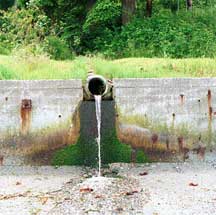Toxins as a measure of ecological function
What are toxins?

There are also human-produced toxins such as manufactured herbicides and pesticides and vehicle emissions like gasoline and oil. Other human products, such as antibiotics and artificial hormones, are proving to have toxic effects in aquatic water bodies, as well.
What increases toxins in our environment?
Agriculture, urban development sewage outfalls and internal combustion motor boats can increase concentrations of toxins. Impervious surface and population concentrations contributes to the rate at which toxins move into an aquatic ecosystem.
Toxins come from the application of pesticides, herbicides and other chemicals. Others are associated with motorized vehicles (toxins from internal combustion engines, brake pads, oil leaks, and other vehicles emissions). Sewer outfalls and combined sewer overflows (CSO) also contribute toxins by transporting toxins not treated by sewage plants or collected through stormwater runoff from impervious surfaces such as roads and driveways.
How are toxins naturally prevented from entering our water?
Wetlands slow down water allowing plants to absorb many of the toxins found in aquatic ecosystems. When wetlands are lost, that ability to remove toxins from the system is taken away. (See information about detention ponds under phosphorus.)
References: Stanley et al. 2005.
Shoreline videos: Life on the Edge
Related information
- Environmental monitoring data
- Animals, plants and habitat
- Lake services and information
- Puget Sound marine topics
- King County watersheds

 Translate
Translate